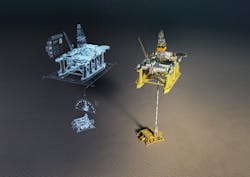4Subsea marks digital twin milestone
Offshore staff
ASKER, Norway – 4Subsea has completed more than 300 measurement campaigns across the North Sea following the launch of its digital twin technology.
The SWIM (Subsea Wellhead Integrity Monitoring) system uses retrofittable subsea sensors to monitor and measure stability, load, fatigue, and structural integrity of the wellhead system during drilling. It has an extended battery life from one to five years and can operate in water depths down to 3,000 m (9,842 ft).
Since it was first tested in 2010, the technology has identified wellhead integrity issues, such as shallow gas and water, conductor stability issues related to wash-out or fatigue challenges, on nearly one-third (30%) of exploration and satellite wells monitored in depths less than 150 m (492 ft).
Peter Jenkins, CEO of 4Subsea, said: “Digital twin technology provides early warning and improved accuracy in structural health monitoring than traditional analyses and its use has grown exponentially over the last decade. In its first five years of operation, SWIM performed around 80 measurement campaigns. This has grown three-fold since 2015, with over 250 campaigns successfully completed across the UK and Norwegian continental shelves.
“We expect that steep escalation to continue as the industry puts more trust in digital twin technology and the financial, logistical and environmental benefits it brings.”
Advanced algorithms, combined with deep domain expertise, are used to analyze fatigue damage accumulation, well support and structural integrity on conductors, wellheads, BOPs, and christmas trees up to the floating drilling rig. This critical data can be used to assess performance, provide prediction analysis and, importantly, rapidly inform decision-making to reduce risk and cost, the company said.
Data is shared in real-time via a user-friendly web application that is easily accessible to the rig crew and the onshore support team. Measured data is securely stored and can be re-used for future model calibration.
With SWIM, operators can re-use critical wells and maximize the lifetime of wellheads by scheduling drilling based on well criticality, historically accumulated load on wellheads, and predictive models. The predictive models estimate the expected load on the wellheads from future planned drilling and intervention operations.
Also, the company has recently launched the SWIM Live app, which provides live data streaming from sensors installed on the BOP and lower flex joint through integration with the BOP MUX umbilical Microsoft Azure. According to the company, this allows real-time updates and the ability to optimize operations with instant insight.
09/21/2021
